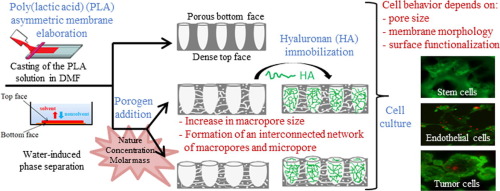当前位置:
X-MOL 学术
›
Eur. Polym. J.
›
论文详情
Our official English website, www.x-mol.net, welcomes your
feedback! (Note: you will need to create a separate account there.)
Microarchitecture of poly(lactic acid) membranes with an interconnected network of macropores and micropores influences cell behavior
European Polymer Journal ( IF 5.8 ) Pub Date : 2018-08-01 , DOI: 10.1016/j.eurpolymj.2018.06.012 Elias Al Tawil , Alexandre Monnier , Quang Trong Nguyen , Brigitte Deschrevel
European Polymer Journal ( IF 5.8 ) Pub Date : 2018-08-01 , DOI: 10.1016/j.eurpolymj.2018.06.012 Elias Al Tawil , Alexandre Monnier , Quang Trong Nguyen , Brigitte Deschrevel

|
Abstract Tissue engineering scaffolds require a three-dimensional architecture with controlled pore size and structure to host tissue formation. Here we used the non-solvent induced phase separation (NIPS) process to prepare porous asymmetric membranes made of poly(lactic acid) (PLA) using dimethylformamide (DMF) as solvent and water as non-solvent. The addition of a polymer additive to the PLA solution has made it possible to increase and control the size of open macropores at the membrane bottom surface and to generate a dual pore architecture consisting of an interconnected network of macropores and micropores. Based on the study of the compatibility of PLA with the polymer additive we propose that the dual pore architecture is generated through a two phase separations process. Membrane surface could be functionalized with hyaluronan (HA) and, whatever the cell type considered, HA-functionalization enhanced cell proliferation. Interestingly, a strong effect of macropore size and surface functionalization by HA on cell colonization and cell proliferation within membranes and membrane morphology on cell organization was demonstrated. Cancer cell lines were able to adopt an in vivo tumor-like behavior, endothelial cells reconstituted a vascular-like structure and mesenchymal stem cells adopted a specific organization which can open perspectives for their use and conservation. These results show that our membranes with controllable dual pore architecture offer great potentialities in tissue and tumor engineering.
中文翻译:

具有大孔和微孔互连网络的聚(乳酸)膜的微结构影响细胞行为
摘要 组织工程支架需要具有可控孔径和结构的三维结构来承载组织形成。在这里,我们使用非溶剂诱导相分离 (NIPS) 工艺制备了由聚乳酸 (PLA) 制成的多孔非对称膜,使用二甲基甲酰胺 (DMF) 作为溶剂,水作为非溶剂。将聚合物添加剂添加到 PLA 溶液中,可以增加和控制膜底面开放大孔的尺寸,并产生由大孔和微孔互连网络组成的双孔结构。基于对 PLA 与聚合物添加剂相容性的研究,我们提出双孔结构是通过两相分离过程产生的。膜表面可以用透明质酸 (HA) 进行功能化,并且,无论考虑何种细胞类型,HA 功能化都增强了细胞增殖。有趣的是,证明了大孔尺寸和 HA 表面功能化对细胞定植和细胞膜内细胞增殖以及膜形态对细胞组织的强烈影响。癌细胞系能够采用体内肿瘤样行为,内皮细胞重建血管样结构,间充质干细胞采用特定组织,可以为其使用和保护开辟新视野。这些结果表明,我们的具有可控双孔结构的膜在组织和肿瘤工程中具有巨大的潜力。证明了大孔尺寸和 HA 表面功能化对细胞定植和细胞膜内细胞增殖以及膜形态对细胞组织的强烈影响。癌细胞系能够采用体内肿瘤样行为,内皮细胞重建血管样结构,间充质干细胞采用特定组织,可以为其使用和保护开辟新视野。这些结果表明,我们的具有可控双孔结构的膜在组织和肿瘤工程中具有巨大的潜力。证明了大孔尺寸和 HA 表面功能化对细胞定植和细胞膜内细胞增殖以及膜形态对细胞组织的强烈影响。癌细胞系能够采用体内肿瘤样行为,内皮细胞重建血管样结构,间充质干细胞采用特定组织,可以为它们的使用和保存打开视野。这些结果表明,我们的具有可控双孔结构的膜在组织和肿瘤工程中具有巨大的潜力。内皮细胞重建了类似血管的结构,间充质干细胞采用了一种特定的组织,可以为其使用和保存打开视野。这些结果表明,我们的具有可控双孔结构的膜在组织和肿瘤工程中具有巨大的潜力。内皮细胞重建了类似血管的结构,间充质干细胞采用了一种特定的组织,可以为其使用和保存打开视野。这些结果表明,我们的具有可控双孔结构的膜在组织和肿瘤工程中具有巨大的潜力。
更新日期:2018-08-01
中文翻译:

具有大孔和微孔互连网络的聚(乳酸)膜的微结构影响细胞行为
摘要 组织工程支架需要具有可控孔径和结构的三维结构来承载组织形成。在这里,我们使用非溶剂诱导相分离 (NIPS) 工艺制备了由聚乳酸 (PLA) 制成的多孔非对称膜,使用二甲基甲酰胺 (DMF) 作为溶剂,水作为非溶剂。将聚合物添加剂添加到 PLA 溶液中,可以增加和控制膜底面开放大孔的尺寸,并产生由大孔和微孔互连网络组成的双孔结构。基于对 PLA 与聚合物添加剂相容性的研究,我们提出双孔结构是通过两相分离过程产生的。膜表面可以用透明质酸 (HA) 进行功能化,并且,无论考虑何种细胞类型,HA 功能化都增强了细胞增殖。有趣的是,证明了大孔尺寸和 HA 表面功能化对细胞定植和细胞膜内细胞增殖以及膜形态对细胞组织的强烈影响。癌细胞系能够采用体内肿瘤样行为,内皮细胞重建血管样结构,间充质干细胞采用特定组织,可以为其使用和保护开辟新视野。这些结果表明,我们的具有可控双孔结构的膜在组织和肿瘤工程中具有巨大的潜力。证明了大孔尺寸和 HA 表面功能化对细胞定植和细胞膜内细胞增殖以及膜形态对细胞组织的强烈影响。癌细胞系能够采用体内肿瘤样行为,内皮细胞重建血管样结构,间充质干细胞采用特定组织,可以为其使用和保护开辟新视野。这些结果表明,我们的具有可控双孔结构的膜在组织和肿瘤工程中具有巨大的潜力。证明了大孔尺寸和 HA 表面功能化对细胞定植和细胞膜内细胞增殖以及膜形态对细胞组织的强烈影响。癌细胞系能够采用体内肿瘤样行为,内皮细胞重建血管样结构,间充质干细胞采用特定组织,可以为它们的使用和保存打开视野。这些结果表明,我们的具有可控双孔结构的膜在组织和肿瘤工程中具有巨大的潜力。内皮细胞重建了类似血管的结构,间充质干细胞采用了一种特定的组织,可以为其使用和保存打开视野。这些结果表明,我们的具有可控双孔结构的膜在组织和肿瘤工程中具有巨大的潜力。内皮细胞重建了类似血管的结构,间充质干细胞采用了一种特定的组织,可以为其使用和保存打开视野。这些结果表明,我们的具有可控双孔结构的膜在组织和肿瘤工程中具有巨大的潜力。











































 京公网安备 11010802027423号
京公网安备 11010802027423号